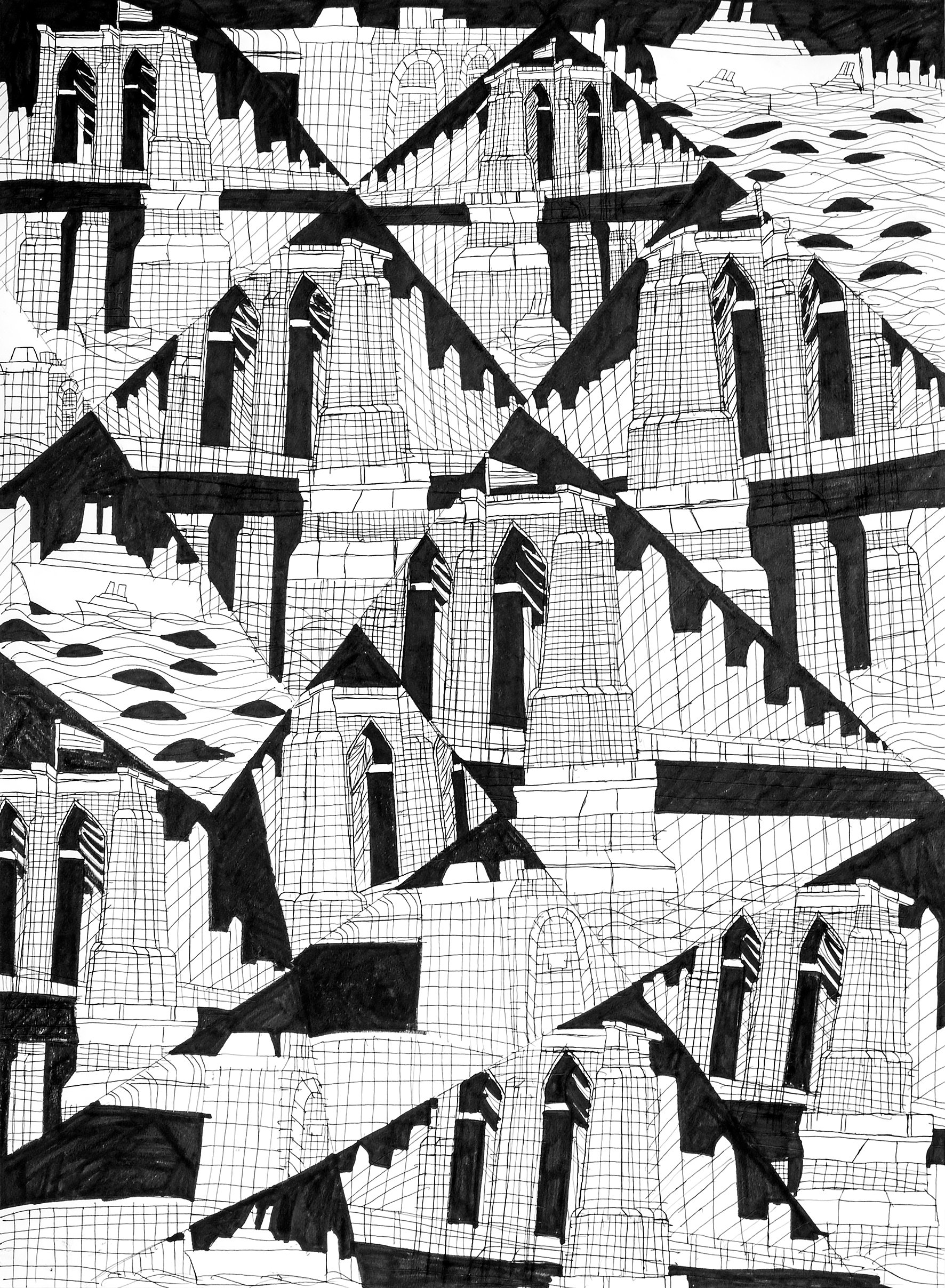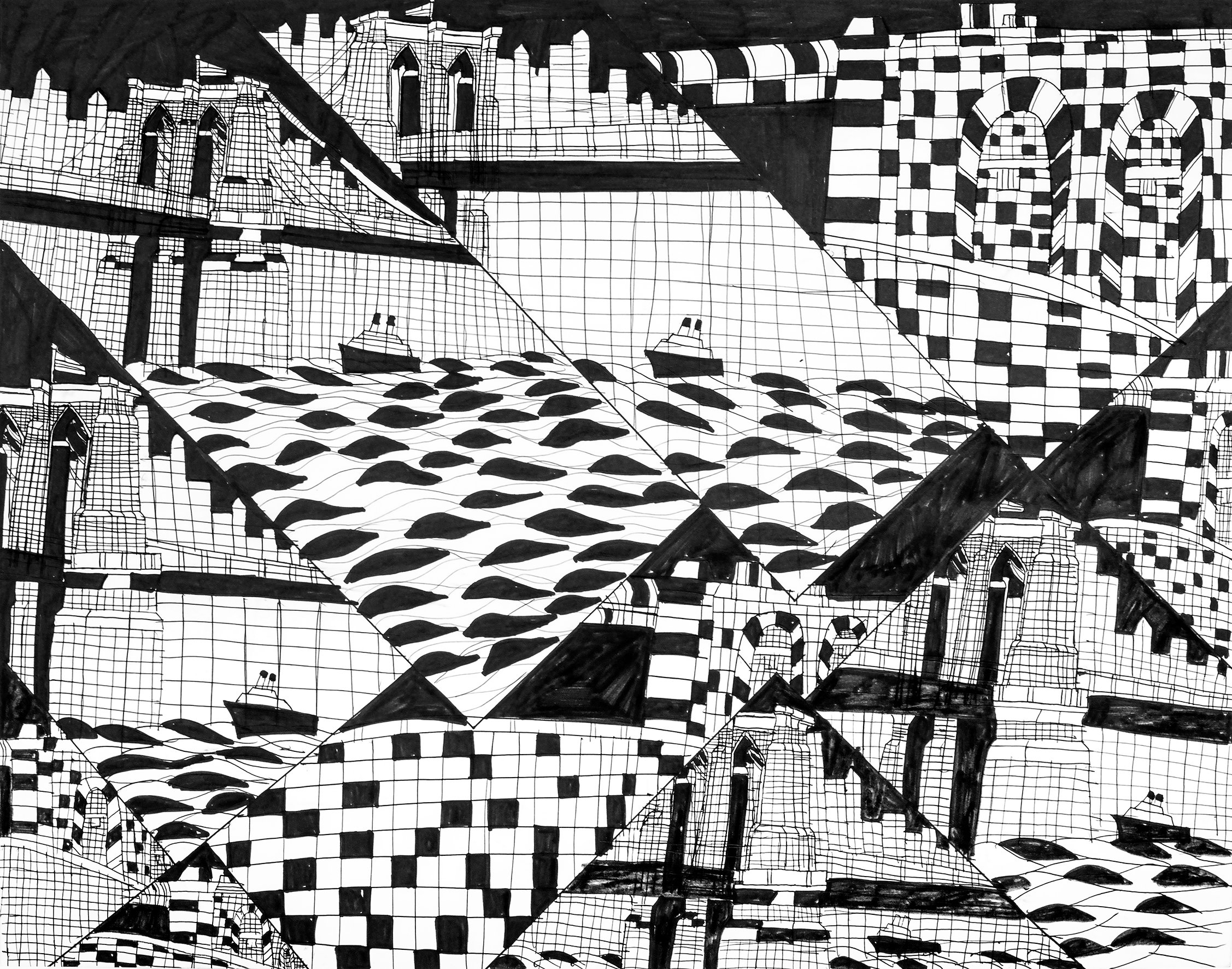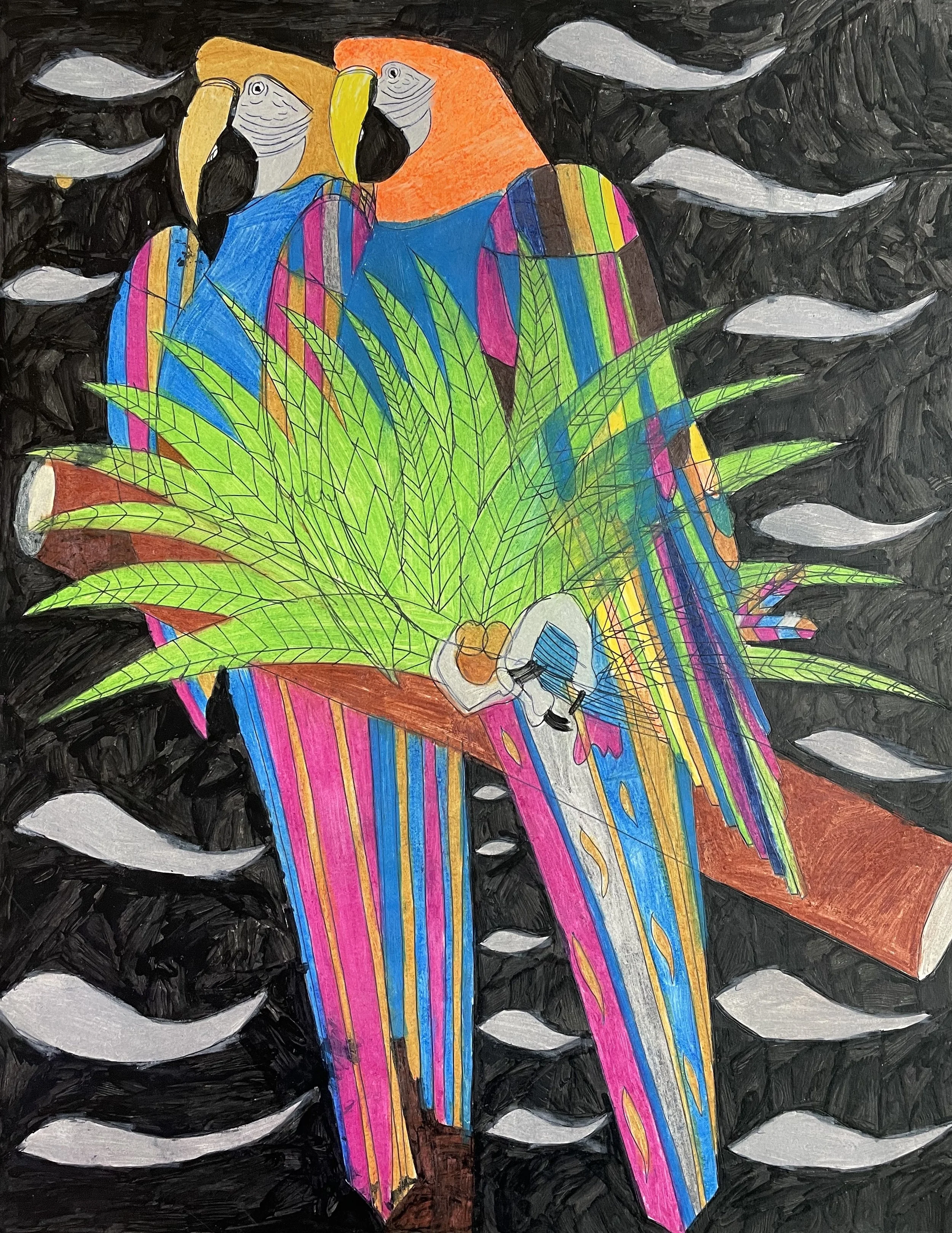
“I do the water different colours. And sometimes when the light source hits the water, it creates a rainbow pattern of colours, all different colours.”
Interview with artist Robert Latchman by Jennifer Gilbert
Portrait of Robert Latchman, courtesy of LAND
Art et al. co-founder Jennifer Gilbert, interviewed Robert Latchman whilst she was in New York taking part in the Outsider Art Fair in February 2024. Jennifer has loved Robert’s work for a long time, including his work in Monochromatic Minds back in 2020 in London. Robert has three main loves for his creative practice: the Brookyln Bridge, his pet macaw and Abraham Lincoln. Read here, or listen, to hear more.
Jennifer: So, Robert, were you born in New York?
Robert: No, I’m from Trinidad. Trinidad and Tobago.
Jennifer: And when did you come over here then?
Robert: When I was around nine years old. When I was living in Church Avenue. Right. And then they took me to a day care, and I was trying to talk when I was here. Something like that.
Jennifer: Do you have any memories of when you lived in Trinidad or not? Do you remember what it was like?
Robert: We had palm trees, beautiful palm trees in the neighbourhood. Exactly. And beautiful sunsets.
Jennifer: Yeah. Do you ever go back and visit it?
Robert: I was there a couple of years back.
Jennifer: Do you still have family there?
Robert: My dad of course.
Jennifer: Ah, so you came over here with your mom?
Robert: Yeah.
Robert Latchman, Angle Shape Cut Out of Boats and the Bridge, 2019, Ink pen on paper, 57x77cm. Photo by Ellie Walmsley
Robert Latchman, Connect the Dots Around the Bridge with Black Ink, 2019, Ink pen on paper, 61x48cm. Photo by Ellie Walmsley
Jennifer: And then do you remember when you might have started drawing?
Robert: When I was, about nine years old. Or maybe ten.
Jennifer: And then when did you start coming to LAND, when it was in the other space?
Robert: Oh, when I was at the other workshop, they found me and found that I was good at art. And Elliot Miller found me in the workshop and brought me to LAND to meet Matthew. That was when it was on the High Street in Dumbo. By the bridge, Brooklyn bridge.
Jennifer: Do you remember how long you have been going for now?
Robert: From when I was 40 something, but I’m 48 now. You see all my greys now!
Jennifer: Ha me too. Do you come here every day?
Robert: Yeah everyday
Jennifer: And so, did you only start drawing the Brooklyn bridge when you moved to LAND as it was by the bridge right?
Robert: Yeah, I started drawing the bridge. Matthew brought me out for observational drawings and when I finished drawing, I became more better about the bridge. Exactly. I became more better and better at mixing the colours, right. The bridge is very exciting to draw. Because you can see every part and then draw every part of it.
Jennifer: So, did it start off just black and white then, when you were drawing it?
Robert: From black and white and then colours came. Exactly. I have a plan for the colours, to colour it all in. To make it become all better. All time perfecto me.
Jennifer: So, you like breaking it down into little, small pieces?
Robert: Yeah, breaking it down for molecules, and learning how to draw it, exactly yeah. And with the bricks you get more detail.
Jennifer: Nice. How many drawings of the bridge do you think you might have done now?
Robert: Well, first it was cardboard and it was a good experience, and look at them now, they are huge.
Jennifer: They’re huge now. Do you prefer the big or the small?
Robert: Well, big ones yeah. If they can find me more cardboard from the supermarkets, I can do more big ones as it’s cheap that way.
Jennifer: How long do you think a big one takes you to finish, from start to finish?
Robert: Well, you take one sketch from a pen right. That is how it comes out good first.
Jennifer: So, you sketch from the pens first and then you add the colour afterwards. Do you like working in coloured pencil or in paint?
Robert: Coloured pencil, yeah. Because coloured pencil pulls out the image, so that it becomes more clean as it is, yeah.
Jennifer: Yeah, that's good. How long do you think it takes, so once you've drawn your pen layout and then you colour it in, how long? Like a few days do you think it would take you to finish one?
Robert: Yes. Well four days it takes me to finish a big one, on one side.
Jennifer: And what else do you like about the bridge? What are the parts at the top of the image that often feature?
Robert: Those are the clouds. The clouds of the sky exactly.
Untitled, n.d., Pencil crayon and ink pen on greyboard, 24x91 inches
Jennifer: Some of the bridge pictures have got big musical instruments on them - tell me about that.
Robert: Yeah, it’s a saxophone. It’s another technique, putting it inside, exactly. The bridge is trapped inside the saxophone! I also draw drums. And I like to draw a circle.
Jennifer: Oh yes, sometimes you draw inside a large circle, I’ve noticed that. Why do you like to do that?
Robert: Because it pulls out the image a little more.
Jennifer: Very interesting. Do you still go down and visit the bridge now that the studio has moved away from it?
Robert: Well, I still have it located it in my memory, yeah. I like looking at the ends of it.
Jennifer: Do you have favourite colour?
Robert: Brown. Brown like the bridge and it is a rich colour.
Jennifer: The pencil you are using is very small, how do you even hold it?
Robert: I just keep using it and sharpening it. I use it until it runs out. I don’t put things to waste.
Jennifer: When we chatted online in lockdown, you said the bridge looks like a kaleidoscope?
Robert: Yeah, I like to think to look at through a glass and it breaks things up, like a laser beam, it breaks things up. It bends the bars and breaks it up.
Jennifer: Sometimes there are little boats and other things?
Robert: Yeah, as they go past. And I do the water different colours. And sometimes when the light source hits the water it creates a rainbow pattern of colours, all different colours. Exactly.
Jennifer: Do you draw anything else?
Robert: I had a macaw, and I drew that a lot, but it died. I had it at home. I used to draw it from photographs. Its name was Sugar. I wouldn’t get another you see, they cost thousands. We bought it from a pet store. This one did not talk, which was a shame.
Untitled (Macaw), n.d., Pencil crayon and felt pen on paper, 19x24 inches
Untitled (self portrait), n.d., Acrylic and watercolour on paper, 18x20 inches
Jennifer: I’ve just seen a clay head of Abraham Lincoln. You like to draw Abraham Lincoln too, why is that?
Robert: He was the 16th president, and he freed the slaves and Charles Woolf shot him in the head. He was watching a play, and the guy came and assassinated him. I like what he did for freeing the slaves, so I’ve drawn pictures of him, and have one on the wall at home. I have drawn him a lot.
Jennifer: Have you drawn any other people?
Robert: Myself. I’ve drawn myself Robert Latchman. And the way he sits and performs. I draw them often when I am at home. There is a painting of me on the wall in the studio. That’s me!
Jennifer: It’s a very different style for you isn’t it.
Robert: Yes, it is. But I just want to keep doing the bridge. It is like building on blocks. They like build ladders and the escape routes, I want to add them. The bridges sell too. I might get some money from it. Money for my art is important.
Jennifer: What would you get with the money?
Robert: I want to pay for a satellite dish so I can get cable over the roof at home, and it is a lot of money.
Jennifer: Do you like to see your work exhibited?
Robert: Yes. It inspires me more to see it exhibited.
Jennifer: What else do you do outside of LAND?
Robert: I just draw. I’ve got to keep that activity going. I do like to take a lap around the neighbourhood and get some fresh air yeah. I also like to do things on YouTube and watch what I want – it’s free on your phone.
Jennifer: And finally, what’s your favourite place in all of New York to visit?
Robert: This studio. I am happy and glad here.
Jennifer: How wonderful to say that. Thank you for sharing more about your life and your art Robert.
—-
You can learn more about Robert on Shelter Gallery’s website - click here
Banner image is from a photograph of Robert in the LAND studio







